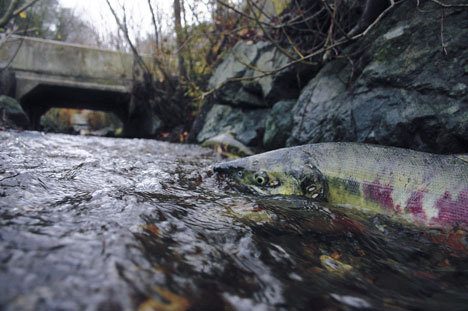Despite severe flooding last spring and another scare two weeks ago, the fish are back in Glendale Creek.
As county crews continue to stabilize the flood-prone tiny beach community south of Clinton, chum salmon have begun their annual spawning migration in the beleaguered stream that runs through it.
After clearing the creek of mounds of debris from April’s flash flood, county crews hustled to respond again two weeks ago as heavy rain deposited four feet of silt in the stream bed.
Crews scooped away silt and debris, and the migrating salmon are making their way upstream.
As a boost, fish are being netted, plopped into a tub of water and carried past obstructions to where they can continue their spawning journey.
“We’re transporting them upstream as we work,” Bill Oakes, Island County public works director, said Monday. “We’ve carried about six adult fish so far.”
The chum salmon spawning run annually occurs in November and December.
Skittish Glendale residents had visions of another flood two weeks ago as heavy rain and suspected beaver activity upstream clogged culverts downstream and pushed the silt-filled creek to its limit.
The county reacted quickly. Crews worked continuously to remove silt and debris, stack sandbags, and to shore up Glendale Road.
Oakes said the creek and road have been mostly stabilized, although more work on retaining walls and embankments remains.
Meanwhile, county officials are collaborating with the state Department of Fish & Wildlife to come up with a permanent game plan for the lower part of the creek.
Glendale resident Lorinda Kay, whose house was severely damaged in April’s flooding, praised county officials this time around.
“The county responded quickly to what could have been another flooding and averted the immediate danger,” she said. “I’m most grateful for their actions.”
Kay said the creek appeared to be clear of silt on Monday morning, and that chum salmon continue to arrive, although some were having difficulty getting past debris in at least one section of the culvert. That will likely change if heavy rain returns and the creek level rises.
“I’m just happy to see the salmon coming back again,” Kay said.
Oakes said the county is working with geotechnical experts to come up with a protection plan for the area. He said he hopes to submit proposals to Fish & Wildlife in a week or two.
“They are our permitting regulator,” Oakes said of the state agency. “They control most of what we do down there.”
He said the county has spent about $25,000 so far in its most recent effort in the Glendale area.
That figure covers the continuous deployment of work crews of between six and 12 people that placed hundreds of sandbags, cleared debris and repaired roadway embankments, he said.
Oakes said beaver activity far upstream may have contributed to the most recent flooding threat.
“There are conflicting reports about whether the dam was breached,” Oakes said. “We tend to believe it was.”
He said the beaver dam in question is on private property, hampering county involvement.
“It’s the property owner’s responsibility,” Oakes said.
The collapse of a portion of a beaver dam in the same area was blamed for triggering the early April flood that forced Glendale residents from their homes and did more than $5 million in damage.
Rising water in Glendale Creek wiped out a 20-foot-deep section of Glendale Road about 100 feet wide, and the culvert under it, and sent a wall of water, mud and debris rushing a mile down the canyon into the Glendale beach community.
Eight homes, the Glendale Hotel and the old Ford Garage were damaged. Residents had been evacuated hours earlier, and there were no reported injuries.
Private property structural damage was estimated at more than $2.1 million, the bulk of it for the heavily damaged Glendale Hotel.
There was an additional $70,000 in estimated personal property loss.
Officials said the county incurred the loss of $2 million worth of roadway, and spent another $60,000 in assisting Glendale residents with the cleanup effort.
Oakes said Monday that the county is continuing to work with residents in the area on how to handle the washout of Glendale Road near Holst Road.
So far, options include creating turnarounds on either side of the gap, installing a large-diameter oblong arch culvert under a repaired roadway, or building a bridge across the divide.
A culvert and repaired roadway, or a bridge, would probably cost more than $1.3 million, officials say. The total package for either option, including stream restoration, has been estimated to cost more than $3 million and would require at least two to three years to complete.
Oakes said the county hopes to make a decision by spring on how to proceed.
Whether or not the washout is repaired, it’s essential to maintain what’s left of Glendale Road, he added, because Humphrey Road, the only other route in and out of Glendale, is also geologically unstable.
In fact, Humphrey Road was washed out as recently as a decade ago, Oakes said.
“They need to have a secondary route,” he said of residents in the area.
As for the weeks ahead, Oakes said the county plans to obtain the necessary permits to be ready for whatever the winter brings.
“Our intent is to get a fix in place,” he said.
“We’re going to do everything we can to ensure that the people of Glendale aren’t flooded again.”



